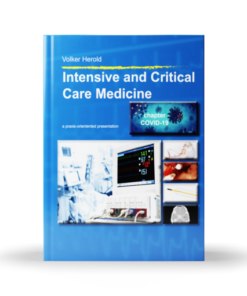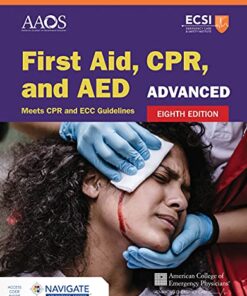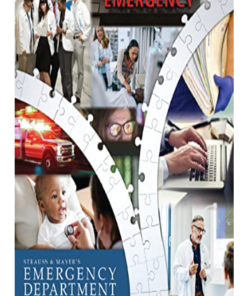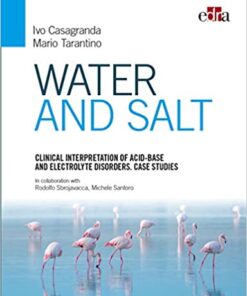- Martin Beed, Consultant in Critical Care and Anaesthesia, Critical Care Directorate, Nottingham City Hospital, UK
- Richard Sherman, Consultant in Critical Care and Anaesthesia, Critical Care Directorate, Nottingham City Hospital. UK
- Ravi Mahajan, Professor of Anaesthesia and Critical Care, Critical Care Directorate, Nottingham City Hospital, UK
- Features easily accessible evidence-based guide for managing emergencies in critical care
- Utilizes the standard “ABC” approach to emergency medicine
- Every topic starts on a new page to aid ease-of-use
- Easy-to-follow classifications of emergencies
- Updated to reflect current national guidelines, recent research and new areas of importance
- Normal values are compiled into one short chapter for quick reference
- Includes a re-written chapter on procedures allowing for better understanding of the practical requirements
By
This essential handbook provides a practical, accessible guide to all emergency situations encountered in the critical care setting. Emergencies are very common in the critical care setting and this book helps critical care staff identify patients at risk, how to manage them, and be prepared. To help the reader find advice quickly, most chapters begin with a generic description of how to manage emergencies affecting that system, or patient group. This is followed by details of specific diagnoses and how they should be managed. The author team, where possible, follow the ‘ABC’ approach, which is not only the standard approach to emergency management, but also a widely-used scheme for documenting daily reviews on ICU, and for documenting trauma management.
This second edition covers new areas of importance, including sections on how to deal with adverse events and critical incidents involving critically ill patients, patient-safety and improved patient rescue packages, and on the practicalities of infection control procedures. Normal values have been combined in to one short chapter for easy reference.
Easy to use and evidence-based, this book will help all critical care staff involved with the management of emergencies, from the new junior doctor to the experienced consultant in a portable and easily-readable format.
New to this edition
Related Products
EMERGENCY MEDICINE BOOKS
Emergências Neurocirúrgicas, 3rd Edition (Original PDF from Publisher)
EMERGENCY MEDICINE BOOKS
Point of Care Ultrasound in Critical Care (ePub+Converted PDF)
EMERGENCY MEDICINE BOOKS
Receituário de Bolso: Emergências Médicas, 1st edition (Original PDF from Publisher)
EMERGENCY MEDICINE BOOKS
AMLS: Advanced Medical Life Support, 3rd edition (Original PDF from Publisher)
EMERGENCY MEDICINE BOOKS
EMERGENCY MEDICINE BOOKS
EMERGENCY MEDICINE BOOKS
100 Cases in Acute Medicine, 2nd Edition (Original PDF from Publisher)
EMERGENCY MEDICINE BOOKS
Emergenze respiratorie. La gestione del paziente acuto e critico (EPUB3)
EMERGENCY MEDICINE BOOKS
EMERGENCY MEDICINE BOOKS
EMERGENCY MEDICINE BOOKS
The Walls Manual of Emergency Airway Management, 6th Edition (EPUB3)
EMERGENCY MEDICINE BOOKS
The Washington Manual of Emergency Medicine, SAE (Original PDF from Publisher)
EMERGENCY MEDICINE BOOKS
MCQS in Critical Care Medicine (Original PDF from Publisher)
EMERGENCY MEDICINE BOOKS
Mechanical Circulatory and Respiratory Support (Original PDF from Publisher)
EMERGENCY MEDICINE BOOKS
EMERGENCY MEDICINE BOOKS
EMERGENCY MEDICINE BOOKS
EMERGENCY MEDICINE BOOKS
Critical Care Transport, 3rd Edition (Original PDF from Publisher)
EMERGENCY MEDICINE BOOKS
Evolution of EMS: COVID-19 Guidance for EMS Providers (Original PDF from Publisher)
EMERGENCY MEDICINE BOOKS
Emergency Pediatric Care Course Manual, 4th Edition (Original PDF from Publisher)
EMERGENCY MEDICINE BOOKS
French AMLS: Support Avance De Vie Medicale, 3e Édition (Original PDF from Publisher)
EMERGENCY MEDICINE BOOKS
Advanced First Aid, CPR, and AED, 8th Edition (Original PDF from Publisher)
EMERGENCY MEDICINE BOOKS
Standard First Aid, CPR, and AED, 8th Edition (Original PDF from Publisher)
EMERGENCY MEDICINE BOOKS
Emergencies in Neuromuscular Disorders (Original PDF from Publisher)
EMERGENCY MEDICINE BOOKS
EMERGENCY MEDICINE BOOKS
EMERGENCY MEDICINE BOOKS
EMS Field Guide BLS Version: Revised 2021, 9th Edition (Original PDF from Publisher)
EMERGENCY MEDICINE BOOKS
EMERGENCY MEDICINE BOOKS
Emergency & Critical Care Pocket Guide, Revised Eighth Edition (Original PDF from Publisher)
EMERGENCY MEDICINE BOOKS
EMERGENCY MEDICINE BOOKS
Neuromonitoring in Neonatal and Pediatric Critical Care (Original PDF from Publisher)
EMERGENCY MEDICINE BOOKS
Emergency Imaging of At-Risk Patients: General Principles (Original PDF from Publisher)
EMERGENCY MEDICINE BOOKS
Manual of Eye, Ear, Nose, and Throat Emergencies (Volume 1) (EPUB)
EMERGENCY MEDICINE BOOKS
Bien débuter – Urgences (French Edition) (Original PDF from Publisher)
EMERGENCY MEDICINE BOOKS
Cases in Pre-Hospital and Retrieval Medicine, 2nd edition (Original PDF from Publisher)
EMERGENCY MEDICINE BOOKS
Perioperative Quality Improvement (Original PDF from Publisher)
EMERGENCY MEDICINE BOOKS
Practical Guide to Interventional Pulmonology (Original PDF from Publisher)
EMERGENCY MEDICINE BOOKS
The Toxicology Handbook, 4th edition (Original PDF from Publisher)
EMERGENCY MEDICINE BOOKS
Atlas of Emergency Medicine Procedures, 2nd Edition (Original PDF from Publisher)
EMERGENCY MEDICINE BOOKS
EMERGENCY MEDICINE BOOKS
Atlas of Emergency Imaging from Head-to-Toe (Original PDF from Publisher)
EMERGENCY MEDICINE BOOKS
Emergency Medicine Board Review for the Visual Learner (Original PDF from Publisher)
EMERGENCY MEDICINE BOOKS
Arterial Blood Gas Interpretation in Clinical Practice (Original PDF from Publisher)
EMERGENCY MEDICINE BOOKS
Der Praxisanleiter im Rettungsdienst, 2e (German Edition) (Original PDF from Publisher)
EMERGENCY MEDICINE BOOKS
Oncologic Emergency Medicine: Principles and Practice, 2nd Edition (Original PDF from Publisher)
EMERGENCY MEDICINE BOOKS
Textbook of Critical Care including Trauma And Emergency Care, 2nd edition (Converted PDF)
EMERGENCY MEDICINE BOOKS
EMERGENCY MEDICINE BOOKS
EMERGENCY MEDICINE BOOKS
Occupational Therapy in Acute Care, 2nd Edition (Original PDF from Publisher)
EMERGENCY MEDICINE BOOKS
EMERGENCY MEDICINE BOOKS
Navigating the ICU: A Guide for Patients and Families (EPUB)
EMERGENCY MEDICINE BOOKS
Communication in Emergency Medicine (Original PDF from Publisher)
EMERGENCY MEDICINE BOOKS
Eye Movements in the Critical Care Setting (Original PDF from Publisher)
EMERGENCY MEDICINE BOOKS
Tratado de medicina intensiva, 2nd edition (Original PDF from Publisher)
EMERGENCY MEDICINE BOOKS
Mechanical Ventilation from Pathophysiology to Clinical Evidence (Original PDF from Publisher)
EMERGENCY MEDICINE BOOKS
Critical Care of COVID-19 in the Emergency Department (Original PDF from Publisher)
EMERGENCY MEDICINE BOOKS
Handbook of Intravenous Fluids (Original PDF from Publisher)
EMERGENCY MEDICINE BOOKS
Rapid Interpretation of Ventilator Waveforms, 3rd Edition (EPUB)
EMERGENCY MEDICINE BOOKS
EMERGENCY MEDICINE BOOKS
CMC Vellore Handbook of Emergency Medicine, 3rd Edition (Original PDF from Publisher)
EMERGENCY MEDICINE BOOKS
Textbook of Emergency & Trauma Care (Original PDF from Publisher)
EMERGENCY MEDICINE BOOKS
A Guide to Mechanical Ventilation in Emergency Room, 2nd Edition (Original PDF from Publisher)
EMERGENCY MEDICINE BOOKS
EMERGENCY MEDICINE BOOKS
Annual Update in Intensive Care and Emergency Medicine 2022 (Original PDF from Publisher)
EMERGENCY MEDICINE BOOKS
EMERGENCY MEDICINE BOOKS
Fundamentals of Pharmacology for Paramedics (Original PDF from Publisher)
EMERGENCY MEDICINE BOOKS
Preparing Nurses for Disaster Management: A Global Perspective (EPUB + Converted PDF)
EMERGENCY MEDICINE BOOKS
Pocket Emergency Medicine, 5th Edition (EPUB + Converted PDF)
EMERGENCY MEDICINE BOOKS
The Washington Manual of Critical Care, SAE (Original PDF from Publisher)







































































































